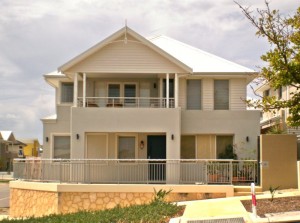
When you are buying a house in Perth, there are a couple of tips that you might like to consider when visiting the property.
Sloping Blocks
Does the house sit on a block that slopes downwards from the street, where the floor level of the home is significantly below the street level? If so, this may cause problems with potential flooding during heavy downpours if the street drainage system fails. Also depending on the location of surrounding homes, a low level home may struggle to capture cooling sea breezes during the summer months. This would reduce the potential of the home to use natural ventilation to cool the house in summer.
Orientation
Check to see if the house has its main living areas facing north. People are becoming more aware of the advantages of northern sunlight, especially during the winter months and the ability to naturally heat your home in winter. If the house has large areas of glass facing east and west, this will cause the home to heat up considerably in summer. This in turn will increase your power consumption as you try to cool the home to make it more comfortable to be in.
If the east and west windows have a substantial eaves overhang or sun awning, this will help reduce the heat gain. Placing trees and vegetation in front of these windows can also be a solution to providing shade to these areas of glass. However, care must be taken when planting trees to make sure that breeze paths aren’t blocked from entering the home, as this will affect the natural ventilation of the home.
Roof Types and Colours
In Perth most homes have either a sheet metal roof (ie zincalume or colorbond) or tiled roof. Tiled roofs are generally made of either clay or concrete tiles.
Clay tiles maintain their colour whereas concrete tiles will eventually fade. This is important to know especially if the home is relatively new. A new concrete tiled roof may look okay now, but a few years down the track might look a bit worn and dated. This could potentially affect the resale value of the property if you ever sell your Perth home in the future.
If fading does occur there is the option of painting the roof, but this is an additional cost you will have to wear down the track. It's also important to understand that darker coloured roofs (whether sheet metal or tiled) tend to absorb more heat than light coloured roofs. This will cause the home to be hot in summer which in turn will increase your energy bills.
Windows
Most Perth homes have either aluminium window frames (most common) or timber window frames. Timber window frames are more common with older homes that were built prior to the 1960’s. Depending on the style of the home, timber windows can add character to a house but be warned, they can also be an ongoing maintenance issue with painting etc. Make sure you check all the windows to see whether they open and close easily. Timber is a natural material which expands in winter as it absorbs moisture and contracts in summer as moisture vapour in the air diminishes.
Aluminium windows have either a powder coat finish (most popular with newer Perth homes built from the 1980/1990’s onwards), or a natural or bronze anodised finish which was very popular in the 1970’s. A natural anodised finish looks like silver metal and does not fade in colour. Powder coat finishes are available in a variety of colours but will fade over time. Fading is more noticeable with darker powder coating colours and with windows that have direct exposure to sunlight.
External Walls
Most Perth houses have external walls that have a face brick finish or a painted rendered finish. Some homes have a combination of both. There is no right or wrong when it comes to which finish is better, as it comes down to personal preference.
However, it’s worth noting that face bricks have the advantage of requiring no maintenance (ie painting), which will save you money down the track. The disadvantage of face bricks is that depending on the colour and type of face brick used, some houses may look dated and tired and in need of a facelift. On the other hand some homes that have face brick walls look timeless. They look just as good now as the day they were built. It’s worth noting that the darker the face brick the more it will absorb heat. This is a disadvantage with walls that face east and west, but can be an advantage with north facing walls.
Unlike face brick walls, houses with rendered walls require ongoing painting, which means additional costs for you in the future. The advantage of painted rendered walls is that you can change the colour of your house walls as fashions change.
When viewing a home from the outside make sure that there are no horizontal cracks (to the outside render or face brick joint) that line up with the top of the window. If there are horizontal cracks to the render or brickwork on either side of the top of the window, it could mean that the steel lintels have rusted. The most probable cause of this is that whoever built the house didn’t use galvanised lintels above the windows. The lintels have more than likely rusted over time which has caused the brickwork and mortar joints to move. This can be a costly defect to repair.
